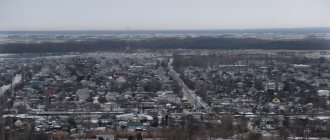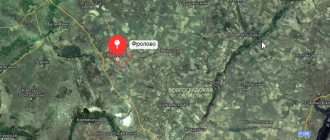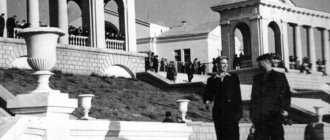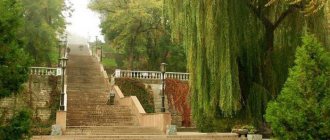Serafimovich, Volgograd region. History and modernity. Interesting Facts.
There are not many real oases of Don Cossack culture left in our country, and one of them is the city of Serafimovich, Volgograd region.
The local population sacredly preserves the military traditions of their ancestors, who defended the fatherland for centuries. In the city itself, little has changed since those times - there are many brick houses with one or two floors, which are more than a hundred years old. The architecture of the Cossack village has been carefully preserved, and the townspeople themselves do not forget about the customs and morals of the Cossacks. The area is included in the country's cultural heritage list.
Serafimovichsky district is a territorial unit with an administrative center in the city of the same name. It includes 15 municipalities, with 14 rural settlements and one urban. The total number of settlements in the region is 73.
The city of Serafimovich, Volgograd region - a flourishing land
There is a city of Serafimovich in the Volgograd region, formerly the village of Ust-Medveditskaya. It is located on the right bank of the Don, and its history is the history of the entire Don Cossacks.
The Cossack town arose at the mouth of the Medveditsa, on the left bank of the Don, in the first half of the 16th century. At the beginning of the 18th century, due to spring floods of the rivers, it was moved to the high right bank of the Don.
In those distant years, the great river, from the headwaters to the mouth, was a transport artery that connected Cossack farms and villages with the center of Russia and the Black Sea.
Thanks to its favorable geographical location, the village developed rapidly. In 1802, the Ust-Medveditsky district arose around it, and the village itself in the 19th century became the largest spiritual, educational, trade and cultural center. Stone houses, churches, gymnasiums, schools, shops and factories were built there.
In 1933, in honor of the 70th anniversary of his fellow countryman, the world-famous writer Alexander Serafimovich, the village of Ust-Medveditskaya received his name and the status of a city. Now on the central square of the city of Serafimovich, the former Gymnasium, there is a monument to the writer, which was opened in 1987.
From time immemorial, the Don region was famous for the military exploits of its heroes. Cossacks continuously carried out military service, participated in all wars of the Russian Empire, and defended its honor and dignity. With full right, one can count K.F. among the heroes of the Don, known outside Russia. Kryuchkova, A.M. Kaledina, F.K. Mironov.
The Great Patriotic War brought hardships to the Don land. The outstanding commander G.K. attached great importance to the Serafimovichi bridgehead. Zhukov. Before the start of the offensive, he held a meeting with the commanders of military units in one of the villages in the region. It was from the Serafimovich-Kletskaya bridgehead that the counter-offensive of Soviet troops near Stalingrad (Operation Uranus) began on November 19, 1942.
8,000 residents of the area went to the front. Of these, 5,656 people died or went missing. Centuries will pass, but the unfading glory of the valiant defenders of the Motherland will live in the memory of our fellow countrymen as an example of unparalleled courage and heroism.
The current Cossacks of the Ust-Medveditsky district strive to be worthy of the glory of their ancestors, reviving the glorious traditions of serving the Fatherland.
The city of Serafimovich in the Volgograd region is famous not only for its rich history, but also for its stunning views. In the entire Middle Don you cannot find such a panorama, such freedom for the eyes and senses. The Donskaya steep, on which the city rises, Obdonya with amazing views attracts and inspires not only poets and artists, but also everyone who has ever visited these places.
The city has preserved its unique architectural silhouette, formed over centuries. The picturesque relief, the steep bank rising above the river by more than 100 m, complement the vertical architectural beauty. The appearance of the houses and the decorative decoration of the facades are distinguished by the severity and restraint typical of classicism.
As a rule, the settlement of a new place began with the construction of a temple. In the Parish Book it is written: “On February 25, the Ust-Medveditsky town, following a petition from the Don Cossacks, was ordered to build a new wooden church of St. Nicholas the Wonderworker.” It was consecrated in 1718, but by 1782 it had fallen into disrepair and a new one was built in its place, in the name of the Resurrection of the Lord with the chapel of St. Nicholas the Wonderworker. This was the first stone building in the village. It was consecrated in 1787.
Another decoration of the village was the Holy Trinity-Pokrovsky Church, consecrated in 1896.
One of the main historical and Orthodox places is the Ust-Medveditsky Spaso-Preobrazhensky Monastery (1652). This is the Orthodox pearl of the Don region. Hundreds of pilgrims and tourists visit it every day: some to pray, others to see with their own eyes the sights of the monastery, including the underground passages dug in 1874 and the miraculous stone.
The city of Serafimovich, Volgograd region, lives a modern life and strives to be an interesting and hospitable host for its guests. The Serafimovichsky Literary and Local Lore Museum operates on the territory of the city. Here you can not only see exhibitions dedicated to the life and everyday life of the Cossacks, but also become familiar with the traditions of the Cossacks and take part in various rituals. The museum staff has developed a tourist route “Ust-Medveditsky Necklace”, which introduces guests to the amazing history of the formation and revival of Orthodox churches, miracles of healing of body and soul, as well as the history and culture of the Don Cossacks.
Picturesque nature, the quiet Don, clean air, floodplain oak forests, wormwood steppe - all this enhances the attractiveness of the ancient Ust-Medveditsky region of the Volgograd region.
The region is rich in unusually beautiful nature. To preserve it, the Ust-Medveditsky natural park with a total area of 59.03 thousand hectares was created in the Serafimovichsky district in 2005. As scientists note, it has become a real “crossroads of worlds.” Its entire territory is built on contrasts, “a combination of incompatible things.” The Don River divides the territory of the Serafimovichsky district and the park into two completely different parts. The right bank is mountainous, steppe, indented by ravines and ravines. The left bank is flat, with lakes. This determines the diversity and variety of landscapes with their own microclimate and appearance.
Ust-Medveditsky Nature Park is a truly wonderful place, combining a rich historical past, interesting natural and archaeological sites and diverse wildlife. Guests from different parts of Russia and neighboring countries have long chosen the banks of the Don, Medveditsa, and Channels in the Volgograd region, and every year the number of tourists is only increasing.
The city of Serafimovich is constantly transforming. Sports and children's playgrounds, parks, and recreational areas are being built and renovated, roads are being laid, sidewalks are being developed, and parks and squares are being actively landscaped.
The beloved region in the Volgograd region lives and blooms with bright colors!
The city of SerafimovichThe city of Serafimovich, Volgograd region
Location
This small town covers an area of only 30.6 square meters. km. Its location is on the banks of the Don, in the northwestern part of the region, 260 km from Volgograd. From different sides, the Serafimovichsky district is surrounded by other regional districts, and only in the west it borders on the Rostov region. Since the area stretches along both banks of the Don, the Don ridge is located on the right bank, and the Archedinsko-Don sands are located on the left.
The local land is rich in natural reserves - there are gas and peat deposits, sources of underground fresh water, deposits of construction sand and raw materials for the production of ceramic bricks and expanded clay.
Serafimovich has transport connections with many settlements in the region and large cities - buses depart from here to Volgograd and Moscow, Surovikino, Mikhailovka, Frolovo, Log, etc. One of the most beautiful places on the high Don bank is occupied by the “Serafimovich pearl” - Ust-Medveditsky Spaso- Transfiguration Monastery.
Serafimovich
It is widely known that Russian Cossacks are quite pious people. Orthodoxy is the main idea of Cossack patriotism. And indeed, on the Don, in almost every village and village, I saw with my own eyes functioning churches and chapels. The village of Ust-Medveditskaya - the current Serafimovich - is no exception.
Ust-Medveditsky Spaso-Preobrazhensky Convent
If you type “Serafimovich” into a search engine, the first thing that appears is links to the monastery. This is a favorite place of pilgrimage in the Volgograd region and an amazing site of cultural and historical heritage, where excursions go all year round. It is located about 5 kilometers outside the city on the high bank of the Don.
The history of the monastery dates back to the 17th century. Its heyday is associated with the abbess of Mother Arsenia, a holy ascetic of noble origin, who was recently canonized as a saint in 2016.
Despite her noble upbringing and habit of comfort, she consciously took on the feat of monasticism from her youth, leaving behind a wonderful monastery, the main temple of which in honor of the Kazan Icon of the Mother of God was designed by Ivan Gornostaev himself, a famous architect, professor at the St. Petersburg Academy of Arts. This is one of the attractions of the monastery, an architectural monument of the 19th century.
The lower temple of the Kazan Church was consecrated in honor of St. Arseny the Great and has an entrance to the caves, which, according to legend, were dug by Abbess Arseny herself.
There she intended to make a cave temple.
Pilgrims are allowed into the caves about 50 meters away (total length 165 m), where another shrine is kept - the stone on which Mother Arsenia prayed. On the stone, as on soft plasticine, there were prints of human palms and knees.
The nuns claim that these are traces of the presence of the Most Holy Theotokos, who appeared to the abbess in prayer. Another decoration of the monastery is the newly built Church of the Transfiguration of the Lord with 33 domes to commemorate the 33 years of the Savior’s earthly life.
Church of the Resurrection
This ancient temple, built at the end of the 18th century, stands almost at the entrance to the city. With its appearance it organizes and enlivens the panorama of the city. And its history contains memories of different periods of the life of the Ust-Medveditskaya village. Probably, this church is one of the symbols of Serafimovich, a kind of beacon for those who were born here. At the beginning of the 20th century, Cossack writer R.M. Krymov wrote about the bell ringing of the Church of the Resurrection that “it joyfully flies from the bell tower, like a bird released from a cage, and hovers in the air for an infinitely long time.” There is still an opportunity for tourists and townspeople to verify this.
Trinity Church (monastery of the Transfiguration Monastery)
An architectural monument of the 20th century, an interesting example of the Russian style. It began to be built as the Church of the Intercession, but the events of 1914-1917. interfered with the construction of the church. Its final restoration was completed in 2015 with the great consecration in honor of the Holy Life-Giving Trinity.
Population
Since 1939, the population of the area has been more than 20 thousand people. It reached its maximum in the 70s, crossing the threshold of 30 thousand people. Then it decreased slightly, but overall remained stable. At the moment it has about 23 thousand inhabitants. Of 1,117 Russian cities, Serafimovich ranks 969th in terms of population. About 38% of the total population of the district live directly in the district center. More than 90% of them are Russians, partly the national composition is represented by Ukrainians and Uzbeks.
Story
The history of the region is closely connected with the Don Cossacks. About 400 years ago, a station was formed on the left bank of the Don. Ust-Medveditskaya. There were picturesque meadows for grazing cattle, and there was also a lot of fish. During the summer, cattle were driven to the right bank, and special bases were even built there. This name still remains to designate the lower part of the city.
In 1802, Ust-Medveditskaya received the status of a village in the district of the Don Army. Fairs were held here in summer and winter, where literally everything was sold. Agriculture developed intensively. Wealthy Cossacks were among the first Russians to use technological innovations - seeders, mowers, and so on.
In the prosperous village there were several small brick factories, a convent, parochial schools, a women's Mariinsky School, two gymnasiums - for men and women separately, four churches and schools for crafts and military purposes.
The Civil War passed almost unnoticed in these places. Soviet power was established peacefully, without bloodshed, at the end of 1917. In the fall of 1918, the Ust-Medveditsky district was captured by Ataman Krasnov, a year later his troops were defeated, but within a year the bandits hiding in the steppes had to be eliminated.
In 1921, the district began to belong to the Tsaritsyn province. The government changed - the laws changed, and the Cossacks were recognized on an equal basis with other peasants - natives and newcomers; they were no longer a privileged class. The emergence of Komsomol cells in settlements occurred in 1920.
In 1928, the Ust-Medveditsky district was formed, which included several villages and adjacent farmsteads - a total of 41 village councils. In 1929, the first collective farms began to be organized, and in 1930 they were already in every locality. Technical stations appeared, and the professions of tractor driver, agronomist, and mechanic became popular. Thanks to technology, by the end of the 30s, many successes had been achieved in the economy; the sown area, compared to 1913, increased by 1.5 times, and the yield doubled. Gardening also developed; in 1934, a nursery was founded; pears, cherries, apple trees, and grapes were grown here.
In 1921, a professional intern club opened, there were already many Komsomol clubs in the village, and reading huts were popularized. The transformations, to a large extent, were associated with A.S. Serafimovich. The writer's real name is Popov. He lived in St. Ust-Medveditskaya from 1874 to 1883, while he was a high school student, and then from 1890 to 1892, when he returned from exile to the city of Mezen, Arkhangelsk region. Since 1933 A.S. Serafimovich often came here and stayed for a long time; a memorial museum is now located in his house.
The renaming of the village to Serafimovich in 1933 was timed to coincide with his 70th anniversary. The writer took care of the improvement of the city. There were three schools, an orphanage, a library, and children's art centers here.
A cultural center was opened in the area, streets were landscaped, parks were planted, some streets were covered with cobblestones, Oktyabrskaya Street was filled with asphalt.
With the arrival of the Germans in these parts, life became completely different. The male population went to the front. In August 1942, the Nazis occupied Serafimovich, but stayed here for several weeks, and then this important bridgehead was liberated at the cost of thousands of lives of Soviet soldiers. And from here, on November 19, the legendary Stalingrad offensive began. Since those times, the Chepelev Kurgan has remained “202 high,” where a 4-sided pyramid now stands as a monument. Eight natives of these places received the title of Hero of the Soviet Union.
After the war, Serafimovich had a hard time recovering, new gardens and parks were gradually laid out, a water supply system and a power plant began operating, and agricultural work was in full swing. Farms for breeding poultry and livestock were created, and by 1950 this industry was not only restored, but also improved the indicators of the pre-war level.
In 1984, the bridge across the river was inaugurated. Don. It became a reliable reinforced concrete structure. Cultural sites were opened in the city, many monuments to soldiers were erected. Now there are medical and educational institutions, trade, food and consumer services facilities here. Agriculture is considered the main economic sector.
Sights of the city Serafimovich
07/14/2020 Do you want to touch our glorious past, covered with legends of Cossack glory, the haze of revolutionary romance and the drama of the civil war? You need to visit the city of Serafimovich.
Are you looking for inspiration from visiting the places where the great Russian writer lived and worked? Come to Serafimovich.
There is a desire to immerse yourself in real natural perfection, in which each of us sees the true embodiment of our native land. Get your route to Serafimovich.
We present here material in which all the beauties and attractions of this glorious city are described in great detail. His story is vivid and tendentious. It was here that the very historical events that were described in many literary works took place. The most outstanding of them is “Quiet Don” by Sholokhov.
If you still doubt whether to visit Serafimovich, read this article in full. You will not remain indifferent!
Each of us, even living in a metropolis, from time to time is transported in our souls to distant, unfamiliar, but dear to every Russian people, lands. Where there is freedom and space. Where, among forests and steppes, a fresh wind blows in your face, the sun gently warms your body, and the pristine silence is broken only by the polyphonic singing of birds. It is easy to breathe in these places, the intoxicating aroma of wild flowers and herbs calms, pacifies, and gives the desire to live forever. From a bird's eye view one can see the shiny ribbons of wide, full-flowing rivers and narrow rivers lost among the trees. Among the fields, the clear eyes of lakes and springs look into the transparent blue sky, and wet ravines keep the secrets of the past. The soul involuntarily wants to get lost here, to choke on this virgin, close to the heart beauty and intoxicating freedom.
From time to time you come across small, quiet villages hidden among green meadows and dense forests. What immediately catches your eye is the attitude of the people living here towards nature, its beauty and gifts - it is not user-driven, but caring and careful. Life here is harmony, agreement and unity with the surrounding world, acceptance of its tranquility, the passage of time, respect for the generosity of nature, awareness of its uniqueness.
***
This is exactly how our imagination pictures our Motherland. Even if we have never been to such places, their images are somewhere inside each of us. Have you tried to wonder what these edges are, have you tried to find them?
Surely, many will be surprised when they find out, and subsequently see with their own eyes, that such visionary paintings can be found near a town named Serafimovich. It is not without reason that in 2005, for its beauty and picturesqueness, as well as in the name of preserving the unique nature, the places of this cradle of the Cossacks were given the status of a natural park. Today, Ust-Medveditsky Park is the youngest of seven natural parks in the Volgograd region. It is located in the southeast of the Serafimovichsky district, on the border of the Volgograd and Rostov regions, spreading over an area of 51.2 thousand hectares.
Ust-Medviditsky Nature Park is a truly wonderful place, combining a rich historical past, interesting natural and archaeological sites and diverse wildlife. Serafimovichsky district is also a land of flowing waters, where you can see the most beautiful natural views of several rivers at once. Namely, the majestic epic Don, quiet, as if drawn from the plots of fairy tales, Khopr and the Bear, cold, mysterious, meandering among the forest thickets of the Channel.
The nature of the Ust-Medveditsky Park is magnificent. One of its main attractions, which captivates the eyes of most guests, is the ravine, slope and floodplain forests that stretch in abundance along the Don, Medveditsa, Khopr and Channel. There are also many springs, picturesque meadows, spacious feather grass steppes, as well as numerous lakes and oxbow lakes.
The geology of the park is characterized by diversity and diversity of landscapes, complexity and originality of structure. All landscape complexes presented here have their own microclimates and differ from each other in flora and fauna, often including rare and endangered species of flora and fauna. Currently, about three hundred species of rare plants grow in the park. The most valuable of them are found in the left bank of the Don. These are the club moss, water chestnut, orchids, red palmate root and Fuchs palmate root. Here you can also find helmeted orchis, bifolia, meadow lumbago, Dubyansky cornflower, Savransky onion. In the floodplain of the Don, in the alder forests, there are rare species of ferns, as well as beautiful white water lilies.
As for the animal world, in the Ust-Medveditsky park there are almost all species of animals found in the Volgograd region - hares, wolves, foxes, roe deer, moose. Every year, a huge number of waterfowl, shorebirds and steppe birds choose these regions as a nesting site. Among them: white swan, fish owl, white-tailed eagle, bustard, little bustard, peregrine falcon. Along some banks, especially old river reservoirs, there are dams and beaver lodges.
Not so far from Serafimovich - literally 30-40 kilometers - on the left bank of the Don there are hidden the most beautiful complexes created by nature itself. One of the most picturesque among them is the Oak Grove, in which hundreds of giant trees grow, some of which have a trunk diameter of several meters. This bright, clean place is endowed with powerful energy. Even a short stay here can fill the body with fresh strength and charge the spirit with inexhaustible cheerfulness and positive emotions. Not far from the grove there is a fabulously mysterious place - Gat - a swampy lake, completely covered with green mud. The cunning and peculiar cunning of nature is frighteningly fascinating, because from the outside it may seem that this is a flat clearing with bright green grass. However, such an innocent impression is deceptive, since under the green “carpet” there is a real viscous swamp, fed by icy underground streams.
There are many other beautiful and unique places on the territory of the Ust-Medveditsky Natural Park. These are: Cold Ravine, Pakhomovskaya Cave, Pyramid Mountain, on which a huge Poklonny Cross is installed, Princely Lake, Koptyuga tract, which is a Bronze Age site. The pictures of the banks stretching along the Don are also indescribably picturesque.
For everyone who wants to plunge into natural beauty, intertwined with the atmosphere of centuries-old history, the Ust-Medveditsky park is currently ready to present educational, historical, cultural, local history, automobile, cycling and water (kayak) routes that cover not only natural, but also historical places. If necessary, vacationers can rent tents, boats, and fishing rods. There are also special parking areas for them where they can light a fire, cook fish soup, and set up camp.
Ust-Medveditsky Park can become not only a place for adults to relax, but also give a lot of impressions to children. For this purpose, a children's camp is located on the banks of the Don. Here, first-class instructors work with the children, and at the request of parents, hiking trips, sports and recreational games can be organized for vacationing children.
***
The city of Serafimovich itself is located on the high, steep right bank of the Don. Its old name is the village of Ust-Medveditskaya. Historically, it arose at the crossroads of water and land routes. There is an opinion that the Cossacks, the founders of the present city, several centuries ago, when creating a village here, did not choose this place by chance. The fast, full-flowing Don, which encircles the area, and the high, steep bank on which the settlement is located served as a natural defense against any enemy, and a surprise attack turned into the most difficult task for him. Thanks to this geography, the residents of the village had a tactical and dislocation advantage, giving them the opportunity to withstand even significantly superior enemy forces. A good overview, opening for many miles from the top of the right bank, made the appearance of the enemy noticeable long before his approach.
To date, by decision of the Russian Union of Historical Cities and Regions, Serafimovich has been included in the list of small historical cities of Russia. The unique architecture of the ancient Cossack village has been preserved here to this day. The bulk of Serafimovich's buildings are one- and two-story brick houses, some of which were built in the 19th century. Also noteworthy is the ancient Market Square, where in former times the shops of the merchant Illirionov were located. The oldest stone architectural structure of Serafimovich is the Church of the Ascension of the Lord with the border of St. Nicholas the Wonderworker. It was built in stone back in 1782.
The city received its name in honor of the famous Soviet writer, author of the legendary novel “Iron Stream,” Alexander Serafimovich, who lived and worked here for many years. This place, according to the writer himself, inspired him, gave him the desire and strength to create.
Today there is a Serafimovich house-museum in the city, where visitors can see the authentic homely atmosphere of the writer’s home. A strict, but at the same time cozy atmosphere: bronze sculptures given to the writer in different years, many large bookcases, a massive desk at which Serafimovich worked - all this has been frozen here since the 40s of the last century. It seems as if the air has remained the same, that it retains some age-old memory.
Next to the writer's house there is a museum of the history of the Ust-Medveditsky Cossacks, where you can get acquainted with various household items of the Don Cossacks. Among them are authentic samples of weapons, tools, documents, paintings and photographs of the late 19th and early 20th centuries. All exhibits are located in five spacious rooms of the museum and clearly demonstrate the original everyday flavor of Cossack life.
Near the western part of the city, not far from the Don, stands the Ust-Medveditsky Spaso-Preobrazhensky Monastery . The moment of its construction approximately dates back to 1652 and is associated with the blessing of St. Patriarch Joachim. Currently, the monastery has been almost completely restored and is inhabited by nuns. The monastery is one of the most visited historical places located on the right bank of the Don. This is a kind of Don pearl, both in spiritual significance and in appearance (today the walls of the monastery are snow-white).
Every day hundreds of tourists and pilgrims come here - some to pray, others to see the sights of the monastery with their own eyes. Among them, the most exciting are the underground passages with a total length of 150 meters dug in 1874. There is an opinion that once an underground passage passed under the very bed of the Don, thus giving the opportunity to move to the left bank. In one of the parts of the caves, the main shrine of the monastery is still located - the “nun’s stone”. On it, as if at the behest of some miraculous forces, there were prints of two palms and knees - according to legend, they belong to Mother Arsenia, who asceticly prayed here. It is believed that if you fall to this stone in heartfelt prayer, you can be healed of a variety of ailments and illnesses.
The history of the monastery is closely intertwined with the history of the local region, inextricably linked with it, and is equally rich in events, many of which are sometimes very tragic. This includes the destruction of the temple during the flood of the Don, and the punitive expeditions sent here by Peter the Great during the Bulavinsky uprising, and the abolition of the monastery in 1788, and the battles that raged here during the Great Patriotic War. But always, in any era and in any event, the monastery was of great importance for the Cossacks, serving as a stronghold of Orthodoxy and the defense of the Fatherland on the outskirts of the Don Land, remaining a reliable refuge for human souls.
With the advent of Soviet power, the monastery was closed. During the Great Patriotic War in 1942-1943, this place became a site of heavy fighting. Then most of the local buildings were destroyed. After the war, a power plant was located here. At the end of the 60s, it was dismantled in a very radical way - through blasting. As a result, only the walls and marble columns survived from the monastery building. In the post-war years, when the monastery was abandoned, considerable damage was caused to the temple by random ill-wishers.
In the early 90s of the last century, the Holy Synod established an independent Volgograd diocese, the head of which was appointed Archbishop German. In 1991, at a meeting of the Synod of the Russian Orthodox Church, at the request of Herman, it was decided: “To bless the opening of the Holy Transfiguration Ust-Medveditsky Monastery in the Volgograd Diocese.” Thus, in 1992, work began to restore the monastery. Perhaps the very first step towards raising the Transfiguration Church from the ruins and returning it to its former appearance was closing access to it - in order to prevent the entry of vandals, window and door openings were blocked. Then, literally bit by bit, the direct restoration of the once brilliant Don pearl began. Initially, it was planned to involve young people in the construction of the temple. But local authorities rejected the option of amateur improvement, preferring professional restoration.
Initially, during the process of restoration and decoration, the monastery functioned as a men's monastery. Its first inhabitants were the rector, hieromonk Savin (Aganin), two full-time hieromonks, one hierodeacon, one monk and several novices. With their direct participation, economic work was carried out in the monastery, the roof of the temple, the vaults between the lower and upper temples were restored, the power station was dismantled, the caves were restored (the icon of the Holy Trinity painted by the brethren is kept in the caves). The abbot's house was also rebuilt (where a refectory was equipped), and a house church was equipped for worship. Today, next to the restored and renovated building of the monastery, stands the Temple of the Kazan Mother of God, also destroyed during the Great Patriotic War.
In August 2001, the Ust-Medveditsky Spaso-Preobrazhensky Monastery was converted into a women's monastery.
***
Now you know where those places are that you have been transported to so many times when you close your eyes. They are just as bright and beautiful, and the air there is just as clean and fresh - exactly the same as in your fantasies. Perhaps you will find time to visit these lands, immerse yourself in their beauty, mystery and centuries-old history. To surrender to the pristine feeling of freedom and lightness, to soar above the world, breaking away from the usual routine. Be sure that you will be greeted here in a friendly manner, and perhaps this is where you will feel for the first time in your entire life that you are finally at home! And it is at this moment that your fantasies will become reality. It, in turn, will turn into bright memories, thanks to which you will return here again and again.
Weather
The climate of Serafimovich is moderate, the winter here is quite long and moderately cold. In summer the weather is very warm, but this period does not last long here. But in warm weather, Volgograd residents and guests from other cities like to relax here.
Therefore, recreation centers were built. Guests enjoy horseback riding and kayaking trips. Fishing deserves special attention - its lovers come here literally all year round, because the bite here is simply excellent.
Job
There are only a few job offers in Serafimovich. Almost all of them relate to the trade sector. You can also find vacancies for work on a rotational basis. For example, according to advertisement No. 1997786062 in Sochi, an employee with a private security guard certificate is required to work as a security guard.
The work schedule is variable with the ability to choose, food and accommodation are provided free of charge, responsibilities include maintaining the customer’s property and access control. Salary – 46 thousand per month + bonus.
Address: 403441, Volgograd region, Serafimovichsky district, Serafimovich city, Blinova street, building 3
Head of the urban settlement of Serafimovich, Serafimovichsky municipal district, Volgograd region: Ilyina Tatyana Nikolaevna Contact phone: 8(8442) 4-13-41, This email address is being protected from spambots. You must have JavaScript enabled to view it.
Rodin Viktor Vladimirovich. Deputy head of the administration of the urban settlement of Serafimovich. Contact phone: 8(8442) 4-36-22
Administration specialists: Kolocharova Elena Ivanovna - 1st category specialist of the administration of the urban settlement of Serafimovich on general issues. Contact phone: 8(8442) 4-13-41
Authority:
- Conducting office work in accordance with instructions
- registration of incoming and outgoing documentation
- registration and maintenance of mail correspondence
Kumova Klavdiya Semenovna leading specialist of the administration of the urban settlement of Serafimovich for land control. Contact phone: 8(8442) 4-34-52
Authority:
- land legal relations
- municipal land control
- reconciliation with MIFTS data on land plots located on the territory of the urban settlement of Serafimovich
- work on citizens' appeals
- issuance of urban planning plans
- issuance of building permits
- issuing permits to put a facility into operation
- issuing decisions on approval of reconstruction and (or) redevelopment of residential premises
Khizhko Tatyana Yurievna is a leading specialist of the administration of the urban settlement of Serafimovich on social issues. Contact phone: 8(8442) 4-34-52
Authority:
- registration of citizens as those in need of residential premises provided under social tenancy agreements (poor people, WWII participants, orphans)
- recognition of citizens in need of residential premises (young families)
- work on citizens' appeals
- participation in the public commission of the urban settlement of Serafimovich on the affairs of minors and the protection of their rights
Berkutova Galina Vasilievna - leading specialist and legal consultant of the administration of the urban settlement of Serafimovich. Contact phone: 8(8442) 4-13-41
Authority:
- contract activities
- participation in the preparation of legal acts
- representation in courts of general jurisdiction and arbitration courts of the Russian Federation
- claim and claim activities
- explanation of current legislation and the procedure for its application
- legal examination in the process of preparing legal acts of the urban settlement administration
- work on citizens' appeals
Bolganova Ekaterina Petrovna is a leading specialist in the urban settlement of Serafimovich on municipal property. Contact phone: 8(8442) 4-34-52
Authority:
- organization of accounting and maintenance of the register of municipal property
- control over the safety and use of municipal property for its intended purpose
- concluding social rental agreements with citizens
- issuance of apartment cards and registration cards for citizens of the urban settlement of Serafimovich
- holding auctions for property
Vasily Valentinovich Vyazov is a leading specialist in housing and communal services and improvement of the administration of the urban settlement of Serafimovich. Contact phone: 8(8442) 4-36-22
Authority:
- monitoring the consumption of energy resources by budgetary institutions and organizations of the municipal complex of the urban settlement of Serafimovich
- improvement issues
- work on citizens' appeals
Kiseleva Tatyana Vladimirovna. Deputy Head of Admin. mountains settlements of the city of Serafimovich in Finnish. question — chief accountant Olga Alekseevna Kulikova. Leading specialist in economic development and accounting Oksana Viktorovna Zavadskaya. 1st category specialist in accounting
Serafimovichsky City Council of the Volgograd Region:
Serafimovichi City Council consists of 10 deputies.
Chairman of the Serafimovichi City Council: Razuvaeva Galina Vasilievna. 8(8442)4-47-83
Deputies:
- Volodin Semyon Alexandrovich. 4-41-24. MKU "SerafimovichSpetsServis"
- Belousova Tatyana Aleksandrovna. 4-49-43, Rosselkhozbank in Serafimovich
- Popov Alexander Eduardovich. 4-47-01 MUP "Ust-Medveditskoye"
- Egorov Vladimir Ilyich. 4-13-05 MKOU "Secondary school No. 2"
- Filatova Elena Gennadievna. 4-32-40 MBUC SG CDC-Director
- Alshanov Alexander Mikhailovich. 4-40-99 GKU TsZN Serafimovichsky district
- Belyaeva Lyudmila Aleksandrovna. 4-35-03 State Budgetary Educational Institution “Serafimovichsky Orphanage”
- Petrova Evgenia Petrovna. 4-34-01 MBOU school No. 1, Serafimovich
- Kazantsev Sergey Vladimirovich. IP Kazantsev S.V.
TOS "Gorbachy" Chairman: Nina Nikolaevna Melikhova. TOS "Bazninsky" Chairman: Elvira Yurievna Senichkina. TOS "Youth" Chairman: Tatyana Ivanovna Naumova. TOS "Prostokvashino" Chairman: Nadezhda Myacheslavovna Fedosova. TOS "Central" Chairman: Valentina Vasilievna Bulavkina.
Official site











